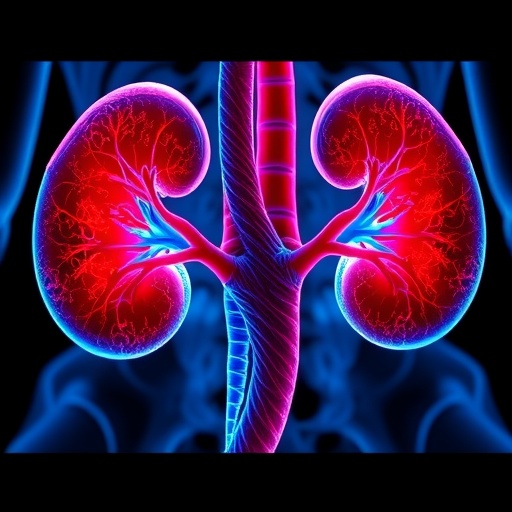In an age where chronic diseases continue to dominate global health concerns, recent advancements in our understanding of hypertensive nephrosclerosis shed light on the intricate mechanisms driving this prevalent condition. A recent study titled “Longitudinal serum proteomics identifies inflammatory and metabolic pathways in hypertensive nephrosclerosis progression” provides key insights into how the body’s metabolic and inflammatory pathways contribute to the worsening of kidney disease in the context of hypertension. The scope of this research underscores an urgent need for targeted therapeutic interventions that can modulate these pathways effectively.
Hypertensive nephrosclerosis is a severe complication of prolonged high blood pressure, resulting in kidney damage and potential renal failure. The accumulation of fibrotic tissue and the consequent loss of kidney function highlight how essential it is to understand the biochemical and molecular changes occurring in the body as a direct response to hypertension. In this groundbreaking study, researchers utilized innovative serum proteomics to capture a comprehensive snapshot of the protein landscape in patients over time, marking a significant advancement in diagnostic methodologies.
Proteomic analysis employs high-throughput technologies that facilitate the identification and quantification of proteins, allowing researchers to better understand their functions and interactions. In the context of hypertensive nephrosclerosis, this molecular profiling provides critical information regarding inflammatory, metabolic, and fibrotic processes taking place within the kidneys. The study reveals that specific proteins associated with inflammation and metabolism show significant alterations over time in individuals suffering from hypertensive nephrosclerosis, offering an unparalleled glimpse into the disease progression.
One of the significant findings in this research is the role of inflammatory pathways in driving the progression of hypertensive nephrosclerosis. As the researchers delved into the serum proteome of affected individuals, they observed elevated levels of pro-inflammatory cytokines and chemokines. These molecules not only signal the presence of an inflammatory response but also amplify the pathological processes contributing to kidney damage. The implication of this finding is profound; it suggests that therapies aimed at mitigating inflammation could potentially slow down or even halt the renal deterioration experienced by patients.
Additionally, metabolic pathways were also highlighted in this study, pointing towards how altered metabolic states in hypertensive patients could further exacerbate kidney dysfunction. The proteomic analysis identified several key metabolic biomarkers that correlated with kidney impairment, suggesting a complex interplay between hypertension, metabolism, and renal health. This disruption in metabolic function underscores the necessity of an integrated approach to treating hypertension that encompasses both cardiovascular health and metabolic status.
The interplay between inflammation and metabolic dysfunction in hypertensive nephrosclerosis suggests a vicious cycle, where one exacerbates the other. As inflammation persists due to uncontrolled hypertension, it may lead to further metabolic disruptions, which in turn contribute to worsening inflammation. Understanding these cycles will be essential for developing effective therapeutic strategies that can comprehensively address the complexities of hypertensive nephrosclerosis.
Moreover, the longitudinal nature of the study enriches the findings, allowing researchers to observe changes in protein levels and pathways over time. This tracking of protein dynamics enables a deeper understanding of disease progression, moving beyond point-in-time assessments to a more fluid understanding of how hypertensive nephrosclerosis develops. By identifying which proteins change at which stages of the disease, clinicians may eventually gain the ability to predict disease progression and tailor interventions accordingly.
The promise of proteomics in the field of nephrology is increasingly evident, as this technology empowers researchers to uncover biomarkers that can enhance diagnostic accuracy. The identification of specific proteins associated with kidney damage can lead to earlier detection of hypertensive nephrosclerosis, enabling timely interventions that could prevent irreversible kidney injury. Early therapeutic processes targeting these biomarkers could be life-saving and significantly enhance patient outcomes.
This study is a call to action for the medical community to leverage the full potential of proteomics in understanding renal pathologies. The insights gleaned from this comprehensive analysis provide a stepping stone towards developing novel diagnostic tools and treatments. As we move forward, multidisciplinary collaboration between researchers, clinicians, and pharmaceutical companies will be crucial in translating these findings into clinical practice.
While the study marks significant progress, it also emphasizes the need for further investigations into how these pathways may be influenced by lifestyle, genetics, and environmental factors. The complexities surrounding hypertensive nephrosclerosis cannot be understated; the interactions between various risk factors often complicate treatment approaches. By gaining a deeper understanding of how these variables affect protein expression and disease progression, researchers can better design personalized treatment strategies for patients.
In summary, the findings from this longitudinal serum proteomics study illuminate critical pathways involved in the progression of hypertensive nephrosclerosis. As we inch closer to unraveling the biochemical intricacies of kidney diseases, it becomes evident that comprehensive approaches that consider both inflammatory and metabolic aspects will be essential in combating these increasingly prevalent conditions. With further research, we can hope for a future where hypertensive nephrosclerosis can be effectively prevented or treated, ultimately preserving kidney function and improving quality of life for those affected.
In closing, this research signifies a transformative step forward not only in our understanding of hypertensive nephrosclerosis but also in the broad arena of chronic kidney diseases. The strides made through technological advancements in proteomics promise an era where tailored therapies become a reality, shifting the focus of medical treatment from merely managing symptoms to addressing the root causes of diseases.
Subject of Research: Hypertensive nephrosclerosis, inflammatory and metabolic pathways.
Article Title: Longitudinal serum proteomics identifies inflammatory and metabolic pathways in hypertensive nephrosclerosis progression.
Article References:
Nordbø, O.P., Eikrem, Ø., Kalra, P.A. et al. Longitudinal serum proteomics identifies inflammatory and metabolic pathways in hypertensive nephrosclerosis progression. Clin Proteom 22, 17 (2025). https://doi.org/10.1186/s12014-025-09537-5
Image Credits: AI Generated
DOI: 10.1186/s12014-025-09537-5
Keywords: Hypertensive nephrosclerosis, serum proteomics, inflammatory pathways, metabolic pathways, chronic kidney disease.




